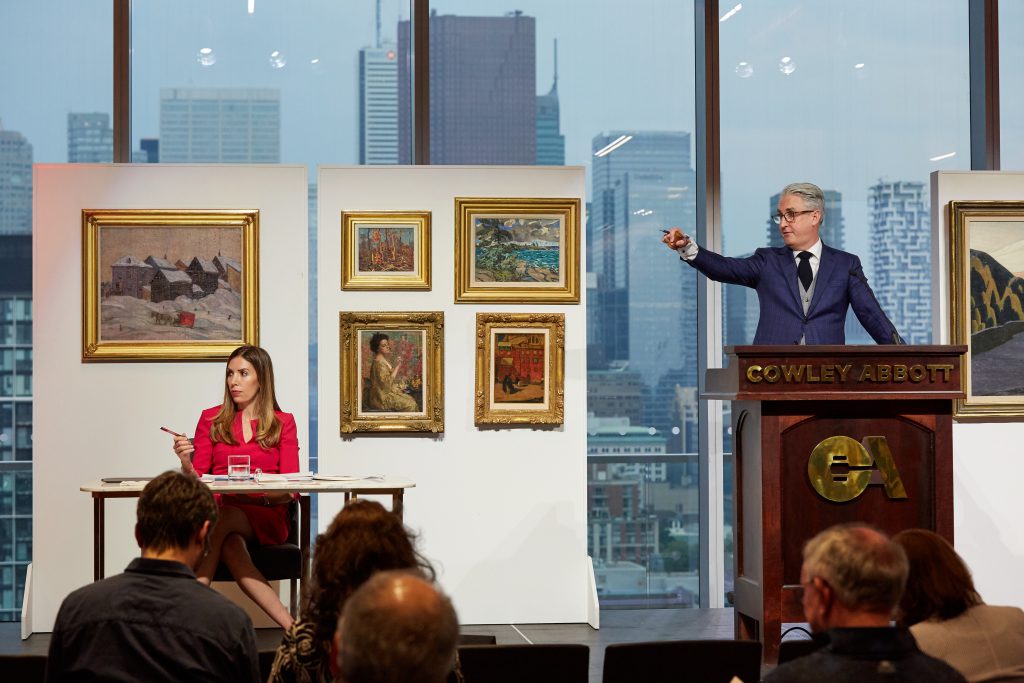
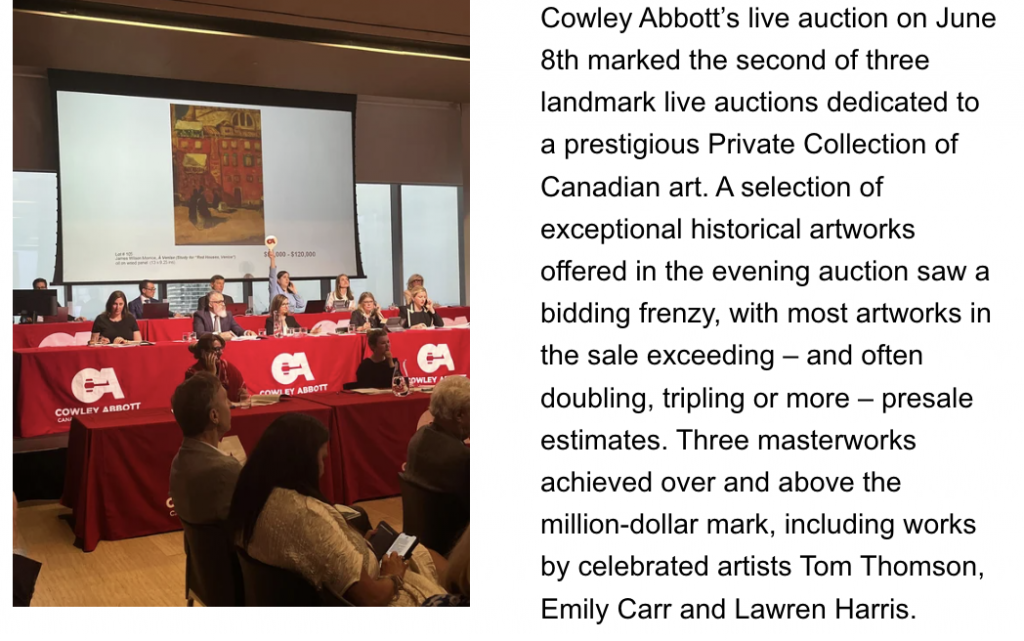
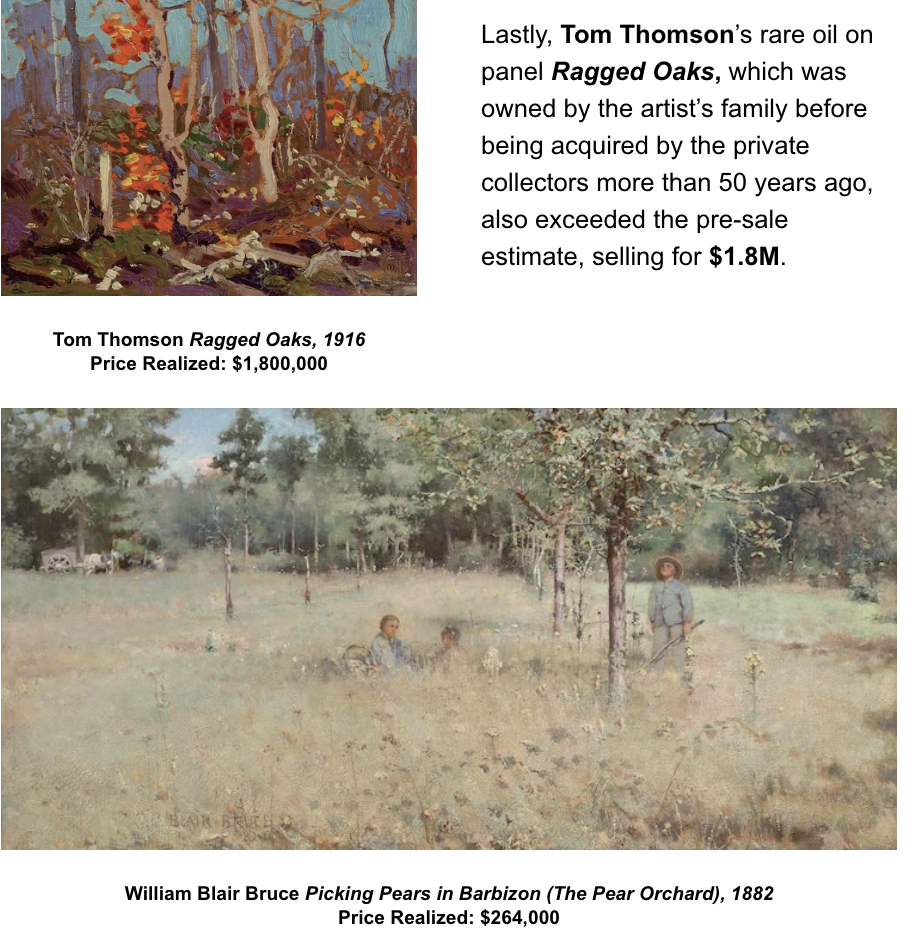
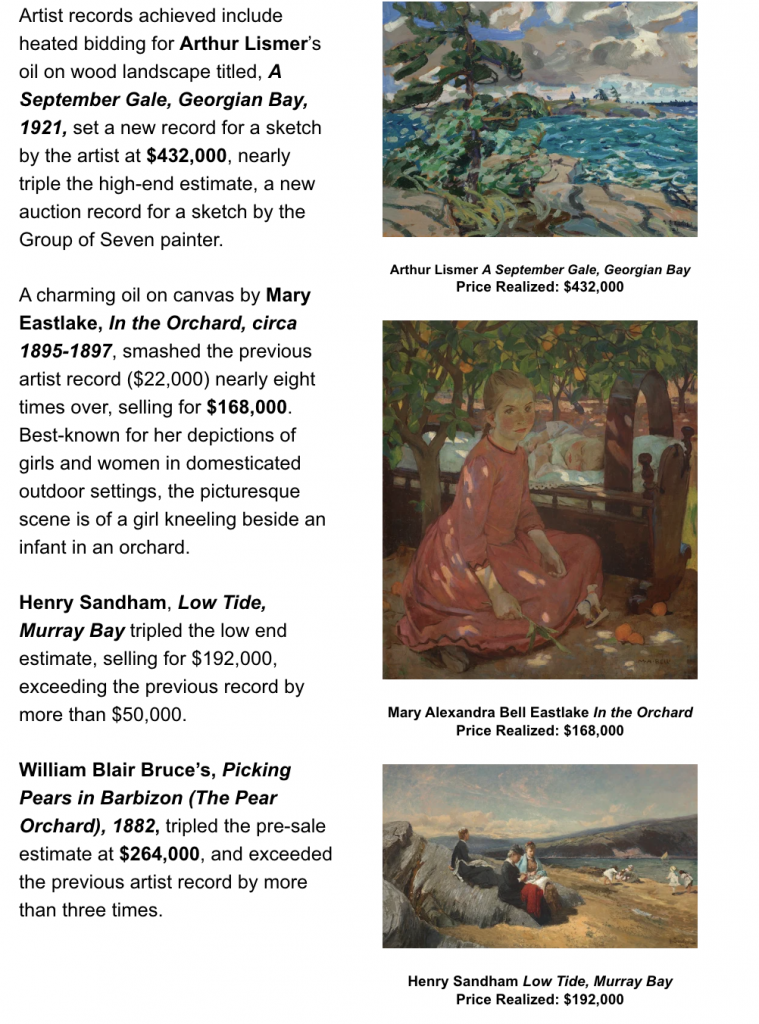
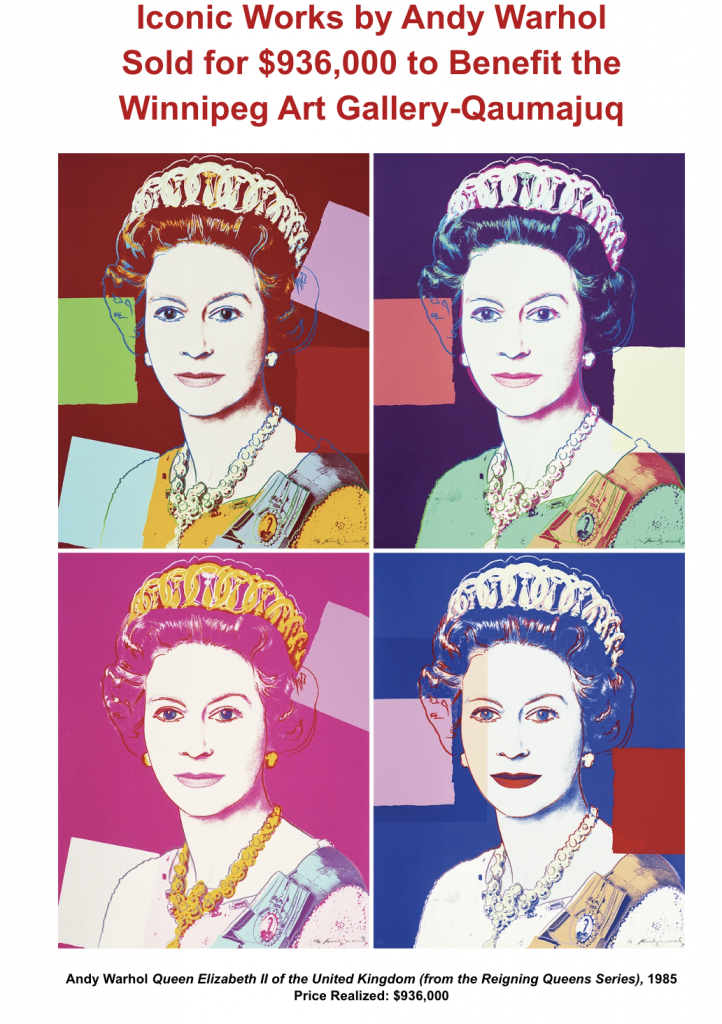
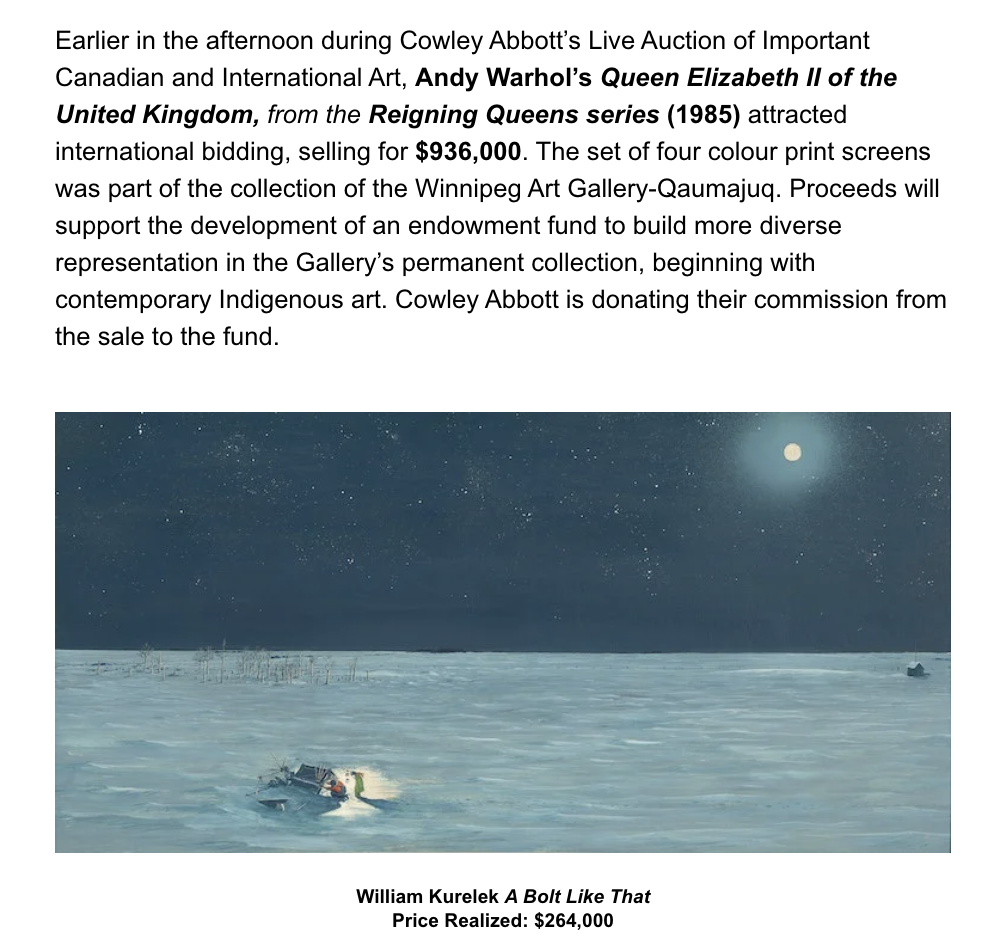
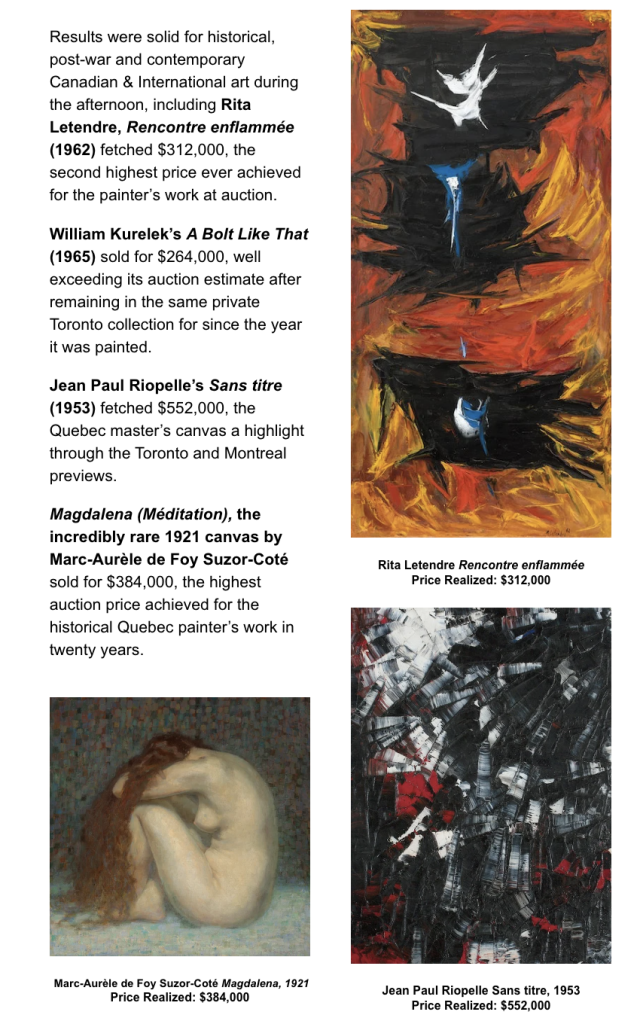









Cowley Abbott’s live auction on June 8th marked the second of three landmark live auctions dedicated to a prestigious private collection of Canadian art. A selection of exceptional historical artworks offered in the evening auction saw a bidding frenzy, with most artworks in the sale exceeding – and often doubling, tripling or more – presale estimates. Three masterworks achieved over and above the million-dollar mark, including works by celebrated artists Tom Thomson, Emily Carr and Lawren Harris.
Cowley Abbott’s two-session live auction event realized incredible results, featuring artworks by international artists Andy Warhol, David Hockney and Joan Mitchell. Nine new auction records were attained for Canadian artists, cementing the sale as a tremendous evening for Canadian art.
Following our record breaking results this season, Cowley Abbott is now accepting consignments for our fall auction, including our major Fall Live Auction at The Globe & Mail Centre on December 6th. Please contact our experienced team of specialists for a complimentary and confidential art valuation.
Tonight! ![]() It is finally time for our two-session Live Auction of Important Canadian and International Art!
It is finally time for our two-session Live Auction of Important Canadian and International Art!
The Cowley Abbott team could not be more excited to present these artworks for sale this evening @globeandmailcentre. It has been a privilege to handle these works of art and share them with collectors, clients and art lovers.
Join us tonight in-person at Toronto’s Globe & Mail Centre or livestream the two auction sessions from home.
![]() Live Auction of Important Canadian and International Art (Session 1) at 4:00 pm EST
Live Auction of Important Canadian and International Art (Session 1) at 4:00 pm EST
![]() Live Auction of An Important Private Collection of Canadian Art – Part II (Session 2) at 7:00 pm EST.
Live Auction of An Important Private Collection of Canadian Art – Part II (Session 2) at 7:00 pm EST.
Beginning as an Automatiste painter in the 1950s, Rita Letendre was influenced by Paul-Émile Borduas’ revolutionary gestural abstract paintings of the period. Although the Automatistes were instrumental in the evolution of her style, Letendre developed a singular vision in her body of work that resulted in a unique style that pushed boundaries of colour, light and space. After being exposed to the major figures of the Plasticiens movement in the mid-1950s, Letendre began experimenting with more structured and geometric compositions. However, by the end of the decade, she returned to a gestural approach, inspired by the Abstract Expressionists in New York‒particularly the black and white paintings of Franz Kline. Her production began to increase, winning first prize in the Concours de la Jeune Peinture in 1959 and the Prix Rodolphe-de-Repentigny in 1960. This prize and the additional sales that followed would allow Letendre to dedicate herself to painting full-time. Always experimenting, she worked in all media while regarding representation in art as “a crutch”.
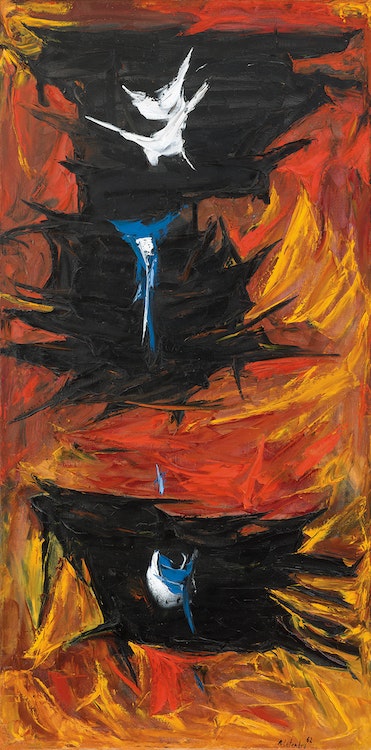
“Rencontre enflammée”, dating to 1962, was completed during this pivotal period of growth in Letendre’s career. As she became better equipped with painting materials and more time to work, she began creating larger canvases with explosions of colour. Letendre had recently won second prize in the painting category in the 1961 Concours artistiques du Québec. Her compositions grew to be very personal and carefully planned, and she began anchoring masses with carefully visualized gestures, amid fields of thick impasto. Dramatic and evocative, Rencontre enflammée is composed of three vertically stacked black organic forms with small, loose strokes of blue and white painted over them. Behind these black masses is a striking ground of yellow and red thrashes that are reminiscent of flames, recalling Letendre’s title which translates to “fiery encounter”. On her use of colour and light, the artist claimed: “Light and colour, and sometimes the absence of colour, have always been the key elements in my painting. With its different values, colour reflects the shades of life. But light, from the first shock of birth to the last breath of life‒light is life.” In this canvas, Letendre plays with this relationship between light, colour and the absence of colour: the three black forms create haunting voids that are encompassed by the mesmerizing light of flames.
Although the title Letendre chose for “Rencontre enflammée” makes reference to a representational subject, her paintings of this time were very much still based in Automatism rather than on a particular subject. She stated, “My thoughts, my attitudes are automatist, which means that I have no set formula. My paintings are completely emotional, full of hair-trigger intensity. Through them, I challenge space and time. I paint freedom, escape from the here and now, from the mundane…The world isn’t only what we see or what we experience.”
The 1960s was a decade of well-deserved recognition for Letendre’s work, beginning with a solo exhibition at the Montreal Museum of Fine Arts in 1961. In 1962, when “Rencontre enflammée” was completed, Letendre received a Canada Council Grant, and travelled with Ulysse Comtois to Europe, visiting Paris, Rome and then Israel.
As the Automatiste group and its affiliates began to abandon their commitment to spontaneity in favour of a more controlled and deliberate structure, Letendre chose to maintain the impulsive and expressive brushstrokes in her work. Letendre kept a fairly consistent palette of dramatic colours, often with large masses of black, until the mid-1960s when she took a decisive shift into geometric compositions once again.
Rob Cowley chats with CP24 Breakfast’s Nick Dixon and Jennifer Hsiung ahead of the June 8th Cowley Abbott Spring Live Auction. They discuss masterpiece work by Lawren Harris, Emily Carr, Andy Warhol, Tom Thomson and David Bowie, each on offer during the upcoming sale.
Cornelius Krieghoff moved to Quebec City in 1853, encountering a vibrant and growing city. As Dennis Reid remarked: “Almost as large as Montreal at a population of some 58,000, close to 40 per cent anglophone (as opposed to the then slightly more than 50 percent anglophone component of the Montreal population) it was the military headquarters for British North America, the centre of the all-important timber trade with Britain, the location of the burgeoning new ship building industry and since October 1851, had been the seat of the government for the province of Canada.”

While pioneer life was rugged and precarious, it was also a productive and fruitful time for Krieghoff as he recorded the industry and ingenuity of the people of Quebec City. At this time, there was no bridge over the St. Lawrence River, and so to cross this mighty body of water to access Lévis on the opposite shore, one had to embark upon a perilous journey in a Royal Mail canoe. Marius Barbeau, Krieghoff’s early biographer, points out that, “The cutting of lumber in the woods and the driving of rafts down the Ottawa and the St. Lawrence gave rise to a great Canadian industry in the earlier part of the nineteenth century, and Krieghoff, like his predecessor Bartlett, interprets some of its aspects upon canvas.”
Few would embark upon this journey across the St. Lawrence River in a Royal Mail canoe unless necessary. Passengers had to lay down or seat themselves in the canoe, which was manned by ten or twelve people. The canoe would be paddled through the open water amidst floating islands of ice. This crossing would take hours and was dangerous, with the passengers often reaching a shoreline that was miles beyond the point at which they had started. According to J. Russell Harper, “The boatmen or canotiers who operated these were a hardy breed who jumped out on the ice floes which impeded their progress and hauled the wooden canoes over the obstacles. Some passengers who gave them a hand received a reduction in their passage money. It was an adventurous trip for the uninitiated, and one of the experiences remembered by visitors to Quebec in the winter months.”
Krieghoff has chosen to depict a heightened scene of drama in this composition of a Royal Mail canoe making its crossing at winter. This canoe bears the responsibility of safe passage for eleven people, which includes a woman seated on a bearskin rug holding her dog, secured in the back half of the vessel. The citadel and ramparts of Quebec City are silhouetted in the distance, anchoring the scene. The energy and hard work involved in this venture, as well as the frenzy and cold nature of the excursion vibrates from the canvas. The boatmen are hustling to pull and push the boat over the ice floes before the vessel freezes in place, while one worker blows a horn signalling their position in the river. No one aboard the Royal Mail canoe seems particularly alarmed by what appears to be an experience that could have an uncertain outcome.
Krieghoff specialized in genre paintings, and this work is a remarkable anecdotal image of the human struggle against ice floes and the ferocity of the upper St. Lawrence River in the depths of winter. Barbeau lists six known versions of this subject, painted between
1859 and 1862. “Under his vivid brush they are alive with fun and movement,” stated Barbeau. A similar variant to this 1860 canvas is “Crossing the St. Lawrence with the Royal Mail at Quebec,” an 1859 canvas in the collection of the Sobey Art Foundation. Krieghoff is known to have painted more than one of the same image in various canvas sizes and also recognized the commercial benefit of lithography, a popular endeavour in this period. A lithograph of a Royal Mail canoe making the arduous St. Lawrence River crossing was produced from one of Krieghoff’s versions of the painting, but the citadel of Quebec City was eliminated.
Krieghoff visited Montreal around the time of the erection of the Victoria Bridge between 1854-59 and sold one of his canvases of the Royal Mail canoe crossing to an engineer working on the project. When a book was issued on the development of this ground-breaking new bridge, Construction of the Great Victoria Bridge in Canada, illustrations demonstrating the inadequacy of the boats used to cross the river in Montreal were included, highlighting the convenience of the new bridge. Krieghoff’s painting of the Royal Mail canoe crossing was included. However, this reproduced image removed the Quebec citadel from the horizon line, declaring the depiction to be in Montreal, thus strengthening the case for the triumph of the Victoria Bridge.
Krieghoff was an artist attuned to the interests of his audience and was beloved by collectors during his lifetime. The legacy of “The Royal Mail Crossing the St. Lawrence” as a treasure within his artistic oeuvre is further solidified by the rarity of a canvas with such an abundance of figures, exquisitely rendered detail and narrative strength. Krieghoff produced dignified paintings that were romantic in nature, evoking the deep roots of the people he encountered and imparting his own vision of historical Canada. Reid argues for “the complex genesis of Krieghoff’s images of Canada”, in which this canvas holds a prominent place.
American artist Andy Warhol once declared “I want to be as famous as the Queen of England”. A leading figure of the Pop Art movement of the 1950s and 60s, Warhol was famous for appropriating familiar images from consumer culture and mass media, including many silkscreen prints of public figures. Determined to become a celebrity himself, he made art out of what people desired most: money, power and fame. Some of his early subjects in the 1960s were photographs of Marilyn Monroe, Elvis Presley, and Elizabeth Taylor. By the following decade, he had garnered sufficient success and recognition that he began to receive portrait commissions from living celebrities including the Shah of Iran, Mohammad Reza Pahlavi, as well as his wife and sister, Mick Jagger, Liza Minnelli, John Lennon, Diana Ross, and Brigitte Bardot. People were eager to be immortalized in Warhol’s signature silkscreen techniques and fluorescent colour schemes.
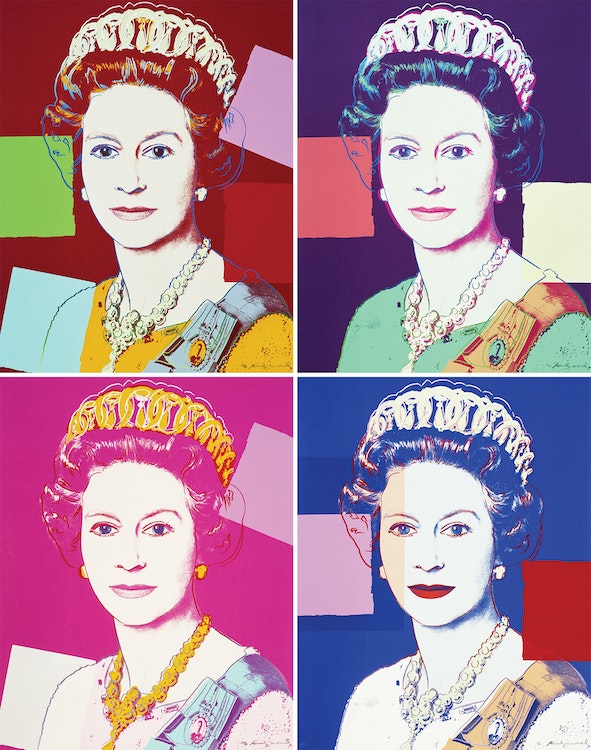
However, there were some public figures who remained out of reach for Warhol. One was Queen Elizabeth II, who was widely considered the most recognizable person in the world. Warhol was eager to make a portrait of her, and in 1982 his European dealer George Mulder wrote a letter to the monarch’s private secretary, Sir William Heseltine. Mulder requested permission for Warhol to create a set of four silkscreen prints using the Queen’s official portrait from the Silver Jubilee in 1977, a photograph taken by Peter Grugeon at Windsor Castle on April 2, 1975. Heseltine replied with an ambiguous, but ultimately favourable response, writing, “While The Queen would certainly not wish to put any obstacles in Mr. Warhol’s way, she would not dream of offering any comment on this idea.”
Delighted, Warhol set to work on his largest and most ambitious portfolio of silkscreens. The result was the Reigning Queens series featuring four prints each of Queen Elizabeth II of the United Kingdom, Queen Beatrix of the Netherlands, Queen Ntombi Twala of Swaziland and Queen Margrethe II of Denmark. These four female monarchs were all ruling in the world at the time of the portfolio’s publication in 1985, and each of them had assumed the throne by birthright, rather than through marriage. Warhol, who was fascinated by universal images, based these silkscreens on the queens’ official state portraits, as these photographs were often mass-produced on currency and stamps. Warhol presents Queen Elizabeth II as an iconic and glamorous figure. “Time Magazine” wrote that Warhol’s portraits of Queen Elizabeth II “treat her like any other celebrity, frozen in time and bright colours”. The repetition of the four prints is reminiscent of postage stamps, referencing the extent of the mass production of the Queen’s image. Warhol has treated the Queen not as a monarch, but as one of the many celebrities he depicted. His approach reinvigorated the traditional presentation of royalty.
The same image of Queen Elizabeth II appears in all four prints but they vary in colour. Each features graphic colour blocks applied separately over the photographs. Warhol began working in this style in the mid-1970s, fragmenting the image with various overlaid shapes and areas of colour. He also added his own outlines, suggesting the stylized make-up of a Hollywood star, and associating the portrait with the cult of celebrity that was prevalent in the 1980s and in Warhol’s œuvre. By comparison to his earlier prints which had a deliberately impersonal, automated appearance, these decorations to the image gave the work a more ‘artistic’ look. With his typical ambivalent attitude, Warhol explained these modifications to his prints as extraneous: “I really would still rather do just a silkscreen of the face without all the rest, but people expect just a little bit more. That’s why I put in all the drawing.”
“Queen Elizabeth II” was well-received by the Royal Collection of the British Royal Family, who wrote that “Warhol has simplified Grugeon’s portrait so that all that remains is a mask-like face. All character has been removed and we are confronted by a symbol of royal power”. George Mulder sent photographs of the prints to the Palace, possibly hoping the Queen might consider purchasing one. Heseltine replied to Mulder: “I am commanded by the Queen to acknowledge your letter of 11th March and to thank you for sending the photographs of the silkscreen prints by Andy Warhol which Her Majesty was most pleased and interested to see”. Later, in 2012, four prints from the Royal edition of “Queen Elizabeth II” were acquired by the British Royal Collection. These prints are the only portraits in the Royal Collection that Queen Elizabeth did not sit for or commission.
The Reigning Queens series combines many of Warhol’s central themes – celebrity, portraiture, consumerism, decoration and social hierarchy.
The four works comprising “Queen Elizabeth II” are printed in an edition of forty with ten artist proofs, five printer proofs and three hors commerce. The work is also published as a Royal Edition with diamond dust on the drawing lines, published in an edition of thirty with five artist proofs, two printer proofs and two hors commerce. These four silkscreen prints are highly coveted, particularly as a complete set, as they had a rejuvenating influence on the nature of portraiture and are some of Andy Warhol’s most celebrated work.
This collection of four works is being sold to benefit the Winnipeg Art Gallery (WAG)-Qaumajuq in establishing an endowment fund to support more diverse representation in the permanent collection, beginning with contemporary Indigenous art. Cowley Abbott is proud to donate our selling commission to the fund as part of the sale.
Joan Mitchell was a prominent American artist closely associated with the Abstract Expressionist movement, the New York School, and international abstract painting of a gestural sort. She spent most of her professional life in France, first in Paris in the 1950s, and from 1967 in Vétheuil, Claude Monet’s home from 1878-1881. While in France she exhibited at the most acclaimed international venues for contemporary art, including 5th Bienal do Museo de Arte Moderna, São Paulo, Brazil (1959), Documenta II in Kassel, Germany (1959), and the 29th Venice Biennale (1958).
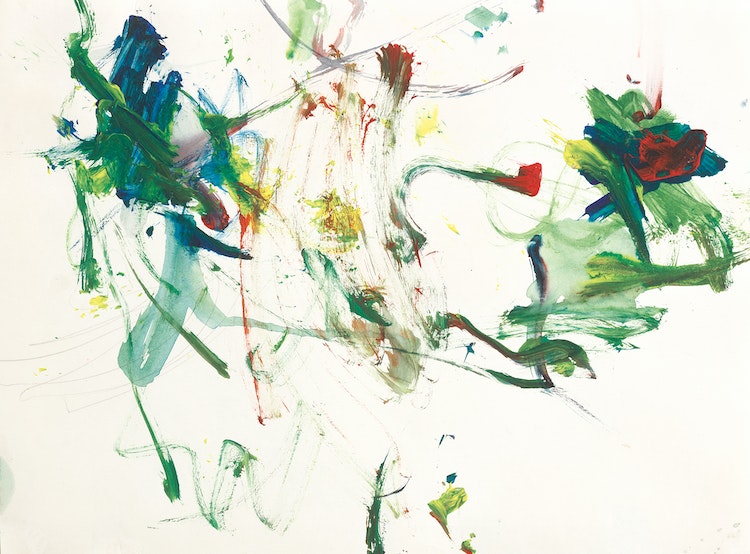
Typical of Mitchell’s art in general, Untitled is both delicate and powerful. She frequently worked on paper, expressing gestures that seem larger in scale than they actually are, in part because the forms animate a fundamentally open space. Areas in the upper left and right of this surface are particularly intense thanks to the accumulation of dark green, red, and blue pigment. If these zones might seem to implode from their own weight, for balance, Mitchell simultaneously thins some of her colours and streaks them across the surface. The light blue and delicate green skeins of pooled colour under the two denser forms to the left and right respectively seem to soak into the surface. Yet Mitchell’s brushstroke is always evident, moving the colour around no matter how ephemeral it becomes. This effect is especially evident in the centre of the work and holds the more heavily worked dancing forms apart.
The comparison of one artist with others in their immediate context or from a longer history is a hallmark of writing about art in museums, auction catalogues, and Art History. Mitchell is often discussed with reference to other women members of the AbEx circle‒Helen Frankenthaler or Lee Krasner, for example‒and especially with respect to her long-time life partner, the Canadian abstract painter Jean Paul Riopelle. Such comparisons can be enlightening, as many witnessed in the 2017-18 exhibition “Mitchell/Riopelle: Nothing in Moderation”, which systematically and extensively placed works by both abstractionists into visual conversation. Nonetheless, comparison invites the establishment of a hierarchy or of a false dichotomy, whether covertly or overtly displayed. It’s worth asking whether we should, in the face of Mitchell’s Untitled, default to comparisons at all.
Is the alternative to perceive this painting on its own terms? Do we see it as highly dynamic, an intimation of a life force and testimony to abstract painting’s abilities, or is it perhaps received as agitated, an embodiment of a delicate rage? The painting does not tell us what to see, think, or feel. It is a testament to what the eminent art historian Linda Nochlin (1931‒2017) ‒Mitchell’s contemporary and friend‒ memorably called the painter’s “poignant visual searching.”
We extend our thanks to Mark A. Cheetham, a freelance writer and curator and a professor of art history at the University of Toronto for contributing the preceding essay. He is author of Abstract Art Against Autonomy: Infection, Resistance, and Cure since the ‘60s (Cambridge University Press).
A founding member of the second group of “Les Plasticiens” in Montréal in 1955 and constantly innovative throughout his long career as a painter, poet, and university teacher, Guido Molinari was a prominent spokesperson for abstract art from the 1950s until the 2000s. There is no abstract painter in Canada who delved deeper into the profundities of the genre than Guido Molinari, which suggests why “Bi-sériel rose” is as vibrant and immediate now as when it was painted in the late 60s.
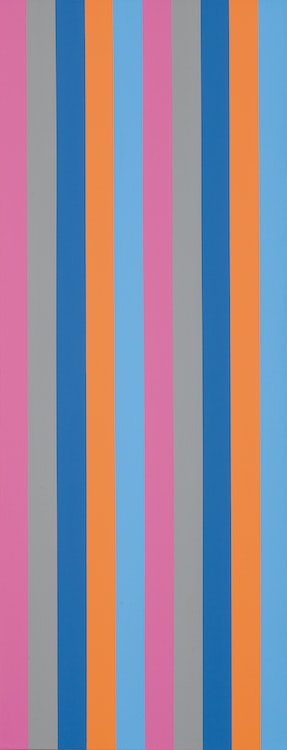
Molinari’s rigorously organized canvases require our close, even literal, attention. Both geometrically regular and chromatically complex, they work optically, corporeally, and intellectually. “Bi-sériel” rose clearly announces its key colour and organizing principle. We see two series of five colour bands; from left to right, rose, grey, darker blue, orange, and lighter blue. Because his individual colours work together (the orange and darker blue as complementary colours, for example), however, in addition to isolated stripes, they stand out as blocks in what remains a repeated sequence with variations. Individual colour columns repeat, but so do pairs of colours. The painting does not allow us to rest optically, nor does it have a stable centre (impossible with ten colour bars, unless one pairs two in the middle, as Molinari does here, leaving four symmetrical flanking columns on the left and right). Instead, our eyes and our bodies (because the painting is vertical and at a human viewer’s scale) are moved by the colour bands. We take part in a chromatic and intellectual game whose conventions are established by the painting. The game is complex but not infinite: the sequence is also clearly bounded by the fame, guaranteeing that the left edge (rose) differs from that at the right (light blue).
While “Bi-sériel rose” is primarily a painting to be taken on its own optical terms, Molinari‒akin to many abstract artists‒responded to the ambient world and encouraged his canvases to reverberate well beyond the frame. The sériels from this period, for example, were inspired by and closely cognate with his interests in the modern classical music of Schönberg and Webern.
We extend our thanks to Mark A. Cheetham, a freelance writer and curator and a professor of art history at the University of Toronto for contributing the preceding essay. He is author of “Abstract Art Against Autonomy: Infection, Resistance, and Cure since the ‘60s” (Cambridge University Press).
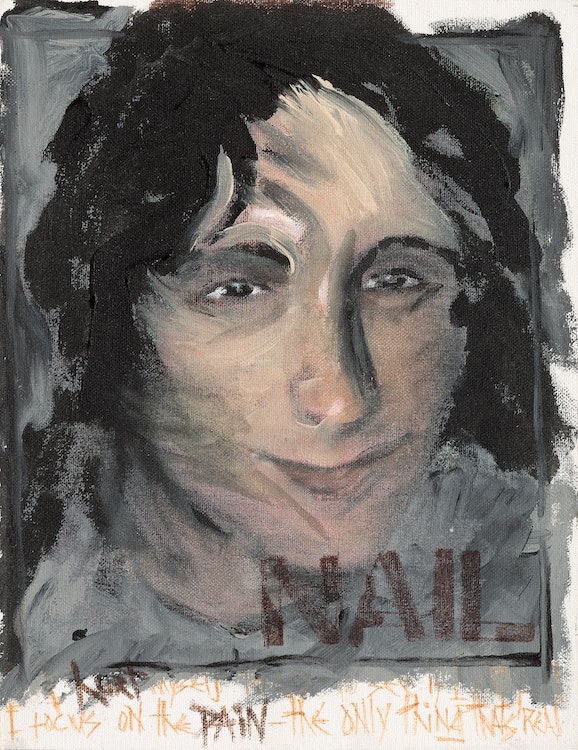
According to the David Bowie expert Andy Peters: “This artwork is another ‘DHead’ of Trent Reznor and includes part of the lyrics written in David’s hand at the foot to NINs big hit ‘Hurt’ which is a unique selling point. This painting never existed in his original inventory of 66 official DHead paintings most of which were made commercially available and was instead part of the rumoured extra 40+ ‘nonpublished’ DHeads he had also created in the period between 1994 and 1997.”
In 1995 Nine Inch Nails opened for David Bowie on his Outside Tour, where he sang ‘Hurt’ with Trent Reznor. During their time spent on tour together in the 1990s, a close friendship was born that lasted until Bowie’s death in 2016. Most famously, they collaborated on ‘I’m Afraid of Americans’, a single from Bowie’s album Earthling.
We would like to thank Andy Peters at davidbowieautograph.com for his assistance with researching this artwork.